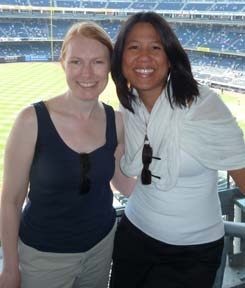
NewYork-Presbyterian Hospital
525 East 68th Street
New York, NY 10065
http://nyp.org/volunteer
Check out NewYork-Presbyterian Hospital's volunteer opportunities at VolunteerMatch.
Debbi and Trish at NYP
"Amazing things are happening here" is <a href="http://nyp.org/" target="_blank">NewYork-Presbyterian Hospital's</a> slogan, and amazing things are certainly happening in its <a href="http://nyp.org/volunteer/index.html" target="_blank">Volunteer Services Department</a>. <br /><br />With over 3,000 volunteers working in 5 different locations, few would label the programs at NewYork-Presbyterian (NYP) program as "small." Yet through an innovative model termed the Volunteer Ladder©, Deborah Cooke, Volunteer Coordinator, and Trisha Choi, Manager of Volunteer Services, have managed to build a sense of community and collective purpose that permeates the halls of one of the most comprehensive university hospitals in the world.<br /><br />Cooke is a program coordinator of volunteer services at NYP. Six years ago, while working with volunteers in an elder care program at the hospital, Cooke saw just how much volunteers impact patients and each other. To help volunteers feel connected, supported, and engaged, Cooke began assigning her more experienced volunteers to assist with the training of newer ones. From the start, the feedback was very positive, and soon the Volunteer Ladder© began to take shape.<br /><br />The Volunteer Ladder© is an innovative training and engagement model for volunteer management. It's similar to a train-the-trainer program where volunteers are given additional responsibilities as they "climb" this ladder. Volunteers are given more responsibility according to their skills and the time they've contributed to the program. <br /><br />At its most basic, people progress from volunteer, to guide, to mentor, to leader. At each level, the volunteers provide training and guidance to those on "lower rungs" of the Volunteer Ladder©, while assuming functions and responsibilities specific to their own positions. This is not necessarily a hierarchical model. Volunteers can move along the spectrum in any number of ways and act in the role on numerous "rungs." <br /><br />As she increased their responsibilities, Cooke realized volunteers can and will do so much more. The Ladder recognizes, develops, and retains volunteers by increasing responsibilities and opportunities. The model contributes to greater efficiency and service delivery to NYP patients and staff. It also offers <a href="http://blogs.volunteermatch.org/engagingvolunteers/2009/11/11/making-room-for-families-in-your-volunteer-program/" target="_blank">flexibility</a> for some of their volunteers. <br /><br />According to surveys that NYP has done, volunteers are now staying longer, doing more, and feeling more valued. Just giving them a title and formalizing their role makes a difference: "The name alone gives what they've been doing validity," says Cooke. "It makes them feel more valued."<br /><br /><strong>Living the Ladder</strong><br /><br />As one of the first to experience the new model, Trisha Choi is a prime example of the success of the Volunteer Ladder©. "I myself have lived the ladder," she said.<br /><br />While working in an administrative role at the hospital, Choi volunteered with a new geriatric program for three years and gave 400 hours of service. During those years, she allowed volunteers to shadow her during shifts, helped with training sessions and attended a conference on geriatrics. <br /><br />When the Volunteer Department received funding for a new oncology volunteer program, Choi was an ideal candidate. As coordinator, she developed a program providing support to cancer patients and met the target of 40 volunteers in the first year. Today, as manager of volunteer services, she leads a corps of 1,200 volunteers in 180 areas. "The Volunteer Ladder© helps me achieve greater efficiency and effectiveness in my position; It can be adapted to any organization." The goal is to roll the model out to as many programs across the hospital as they can. <br /><br />Recently, Cooke, Choi and NYP Volunteer Services staff have begun sharing the program with other organizations. This October, for example, they presented a workshop on the model at the national conference for the <a href="http://www.ahvrp.org/" target="_blank">Association for Healthcare Volunteer Resource Professionals</a>. <br /><br />A big part of the success of the program is how much volunteers appreciate the rich relationships they form with other volunteers – an opportunity they didn't have before. Cooke says, "When I interview volunteers and tell them about the Volunteer Ladder©, their eyes just light up… If you give people responsibility they'll go for it. You just have to ask."<br />
